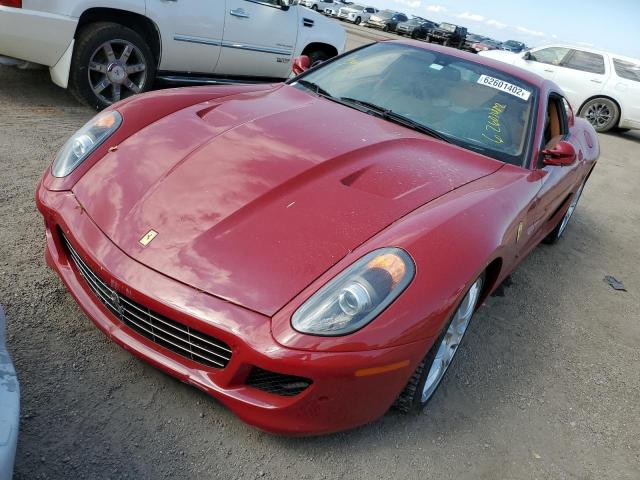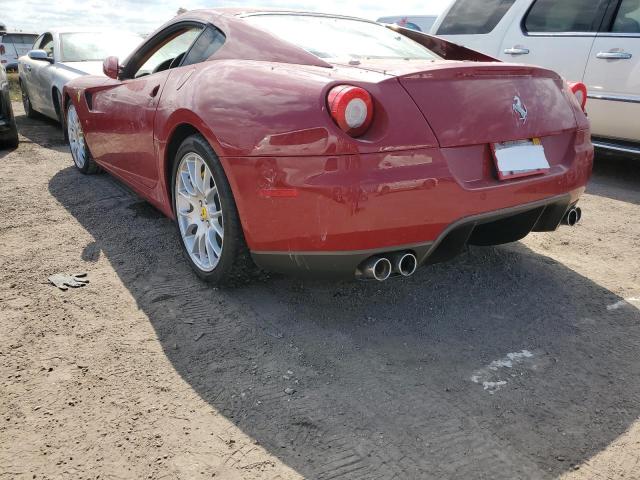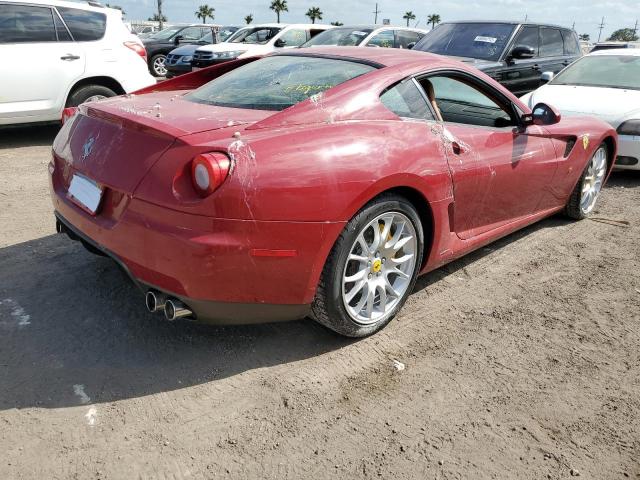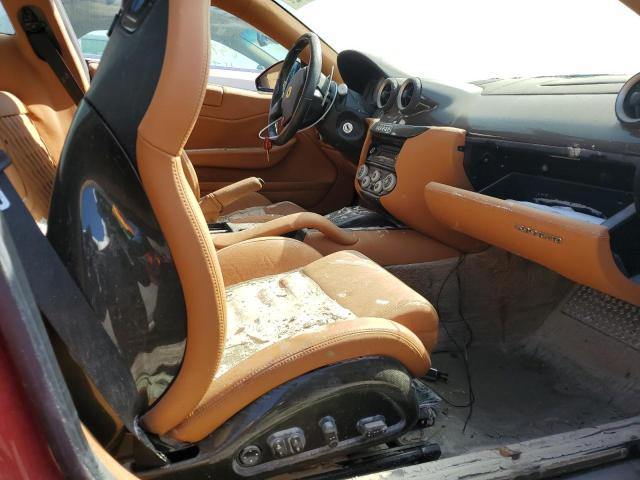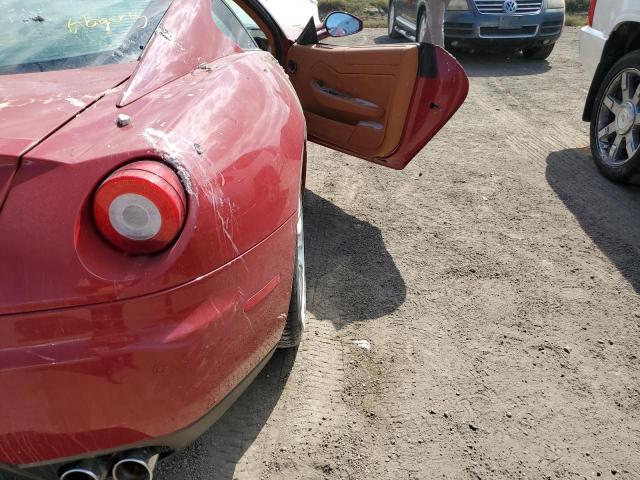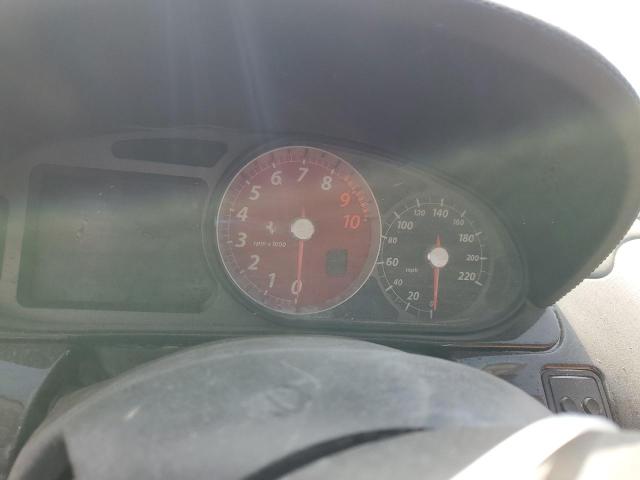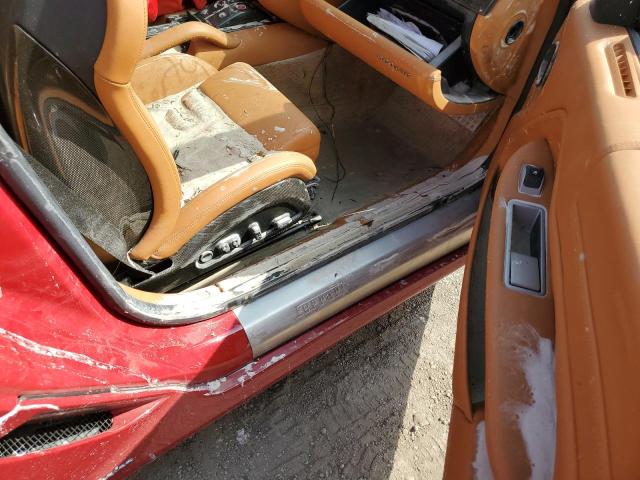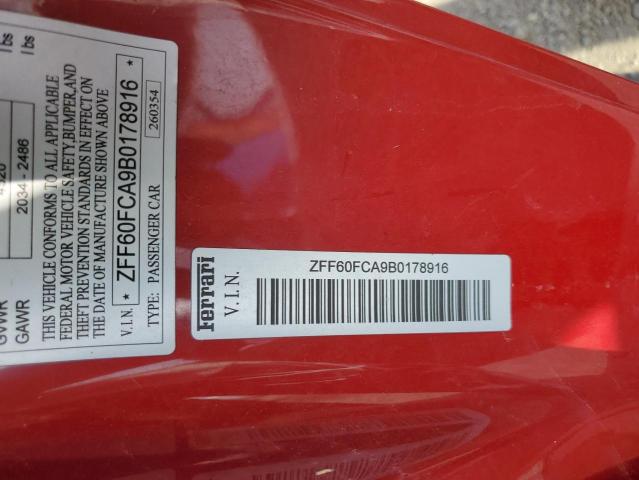2011 FERRARI 599 GTB FIORANO | ZFF60FCA9B0178916
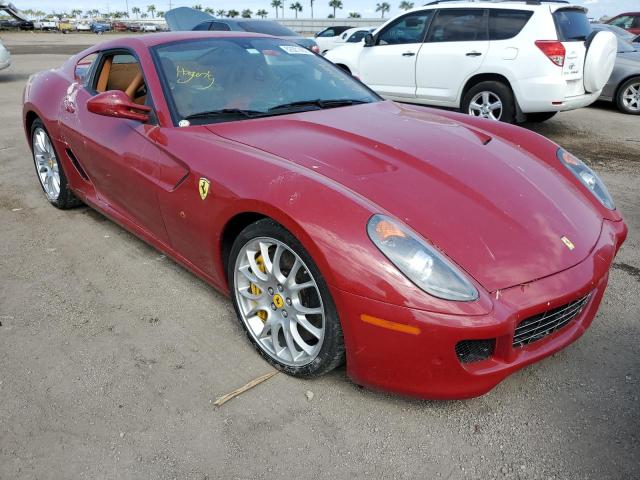 ❯
❯
Specifications
2
~$450,000
Engine: 6.0L naturally aspirated V12
Torque: 620 Nm
0–100 km/h: ~3.3 s
The Ferrari 599 GTO was a road-legal race machine engineered from the experimental 599XX track car — a distilled expression of front-engine V12 performance. With a 6.0L naturally aspirated V12 producing 670 horsepower, it accelerated from 0–100 km/h in just 3.3 seconds, making it the fastest production Ferrari at the time of its launch.
Extensive weight-saving measures — including carbon fiber panels, thinner glass, and a stripped-down interior — reduced overall mass by over 100 kg versus the GTB. The recalibrated F1 SuperFast 6-speed gearbox shifted in 60 milliseconds, and the GTO incorporated advanced magnetorheological dampers, carbon-ceramic brakes, and a side-slip angle control system derived from Formula 1.
Aerodynamic improvements included a redesigned front splitter, rear diffuser, and vortex generators, generating additional downforce without resorting to a rear wing. Despite its rawness, the GTO remained road-legal and remarkably driveable, offering steering feel and throttle response unmatched in its class.
The Ferrari 599 GTO wasn’t just a special edition — it was the spiritual successor to the 288 GTO and 250 GTO: fast, rare, and intensely focused. It earns its place as one of the ultimate front-engine V12 Ferraris and a modern classic in any high-performance registry.
Body Styles
Coupe (599 GTB Fiorano / HGTE / GTO) – a dramatic, long-hood front-mid–engine grand tourer with fastback styling and a full aluminum chassis. Designed by Pininfarina under Jason Castriota, the 599 GTB introduced F1-derived aerodynamics and the Enzo-derived V12, making it the most powerful roadgoing Ferrari of its time. The HGTE version added tighter suspension, quicker shifts, and stiffer anti-roll bars for sharper handling. The GTO was a lightweight, hardcore variant based on the 599XX and limited to 599 units.
Convertible (599 SA Aperta) – an ultra-limited open-top version of the 599 GTO, honoring designers Sergio and Andrea Pininfarina. Only 80 examples were built. It featured a lower windshield, stiffer chassis, removable soft top, and a more relaxed grand touring setup compared to the GTO, though performance remained exceptional.
Model Name Meaning (Manufacturer)
“599” refers to the engine displacement (5,999 cc), “GTB” means Gran Turismo Berlinetta, and “Fiorano” pays homage to Ferrari’s Fiorano test track. “GTO” stands for Gran Turismo Omologata, a legendary nameplate previously used only twice – on the 250 GTO and 288 GTO. “SA Aperta” stands for Sergio and Andrea, Open – a tribute to Pininfarina and a nod to exclusivity.
Model Name Meaning (Languages)
Ferrari maintained a tradition of technical and heritage-based naming, universally understood by enthusiasts. “GTB” and “GTO” are deeply rooted in Ferrari culture, instantly recognizable across global markets. “Aperta” is Italian for “open” and was widely used by Ferrari for ultra-exclusive, open-top variants.
Body & Interior Colors and Rims
The 599 range came in classic and modern hues: Rosso Corsa, Grigio Silverstone, Nero Daytona, and Giallo Modena were staples, while more elegant choices like Blu Pozzi, Rosso Fiorano, Argento Nürburgring, and Bianco Avus were often seen on HGTE or SA Aperta models. The GTO offered exclusive liveries such as Rosso Scuderia with tricolore stripes, matte Grigio Opaco, and historic race numbers.
Interiors were luxurious yet performance-focused. Standard 599s offered leather Daytona seats, carbon or aluminum trim, and a digital cluster beside the analog rev counter. The HGTE added carbon-backed sport seats, a sportier steering wheel, and quilted leather details. The GTO used Alcantara, tech fabrics, bare floors, and roll-bar bracing behind the seats. SA Aperta combined open-air elegance with full carbon trim, bespoke leather colors, and embroidered headrests.
Wheel options included 19-inch and 20-inch alloys, with forged five-spoke and multi-spoke designs in silver, anthracite, or matte black. The GTO had lightweight race-style wheels and carbon-ceramic brakes with painted calipers (red, yellow, black, silver). Fiorano Handling Package (or HGTE) also included sport tires, recalibrated magnetorheological dampers, and a quicker F1-SuperFast gearbox with reduced shift time.
Top Expensive Options
- HGTE Handling Package: ~$20,000
- Carbon Fiber Interior Upgrade Pack: ~$9,000
- LED Carbon Steering Wheel (GTO style): ~$5,200
- Diamond-Cut Forged Wheels with Titanium Lugs: ~$6,000
- Painted Historical Racing Stripe or Roundels (GTO): ~$10,000
- Tailor Made Leather & Alcantara Combo Interior: ~$8,500
- Carbon Ceramic Brakes (Standard on later models): ~$16,000
- SA Aperta Custom Roof Color & Badging Package: ~$12,000
- Reversing Camera + Parking Sensors: ~$2,800
- Luggage Set Matched to Interior Trim: ~$4,000
vs Competitors
The Ferrari 599 GTB Fiorano, produced from 2006 to 2012, was Ferrari’s flagship V12 grand tourer of the era — a front-engined masterpiece that combined exotic styling, Formula 1-derived technology, and astonishing performance. It replaced the 575M Maranello and quickly became one of the most powerful and sophisticated GTs of its time. In the ultra-luxury performance category, the 599 competed with elite rivals like the Aston Martin DBS, Lamborghini Murciélago LP640, Bentley Continental GT Speed, Porsche 911 Turbo (997), and later, even the Mercedes SLS AMG.
Against the Aston Martin DBS, the Ferrari 599 delivered significantly more power and sharper performance. The DBS, with its 6.0L V12 and stunning design, leaned more into emotional grand touring, whereas the 599’s 6.0L V12 — derived from the Enzo hypercar — offered 620 hp, an 8,400 rpm redline, and ferocious acceleration that made it more supercar than GT. The 599 was quicker, more agile, and loaded with tech like magnetorheological dampers and F1-SuperFast paddle-shift transmission, giving it a decisive edge on the road and track.
When compared to the Lamborghini Murciélago LP640, both cars offered V12 power and dramatic presence, but in very different packages. The Lambo was mid-engined, all-wheel-drive, and brutishly raw; the Ferrari was front-mid-engined, rear-wheel-drive, and more refined. While the Murciélago wowed with its design and presence, the 599 offered better everyday usability, superior visibility, and more predictable handling, while still delivering a thrilling, high-revving experience.
Versus the Bentley Continental GT Speed, the Ferrari again stood out for its lightness, sharpness, and purist appeal. The Bentley was more luxurious and subdued, with all-wheel drive and twin-turbo W12 power, but it couldn’t match the 599’s track-focused engineering or its highly responsive chassis. The Ferrari was a driver’s machine in every sense, while the Bentley catered more to high-speed comfort and prestige.
The Porsche 911 Turbo (997) was more compact, more affordable, and incredibly capable — especially in poor weather thanks to its AWD layout. But the 599 belonged to a higher echelon of performance and exclusivity. Where the Porsche impressed with clinical speed and usability, the Ferrari offered emotional depth, a screaming V12 soundtrack, and a handcrafted, bespoke interior that elevated the experience to something far more special.
By the time the Mercedes SLS AMG entered the scene in 2010, it offered similar front-mid-engine balance, a charismatic V8, and gullwing doors for added drama. Still, the 599 remained more refined and dynamically capable, especially in its later GTO form, which pushed performance to near-racecar levels. The SLS was thrilling and loud, but the 599 GTO — with its 670 hp, faster gear changes, and lightweight construction — was one of the most hardcore front-engined Ferraris ever built.
Fun Fact
The 599 GTO was, at its debut, Ferrari’s fastest road car ever around Fiorano – beating even the Enzo by over a second. It also introduced Side Slip Control (SSC) in a V12, paving the way for future models like the F12tdf and 812 Competizione. Meanwhile, the manual 599 GTB – offered only in tiny numbers – is now one of the rarest and most collectible manual Ferraris of the 21st century.
Lot Details
Final Bid Ferrari 599 (2011)
$40,750
$40,750
$40,750
Specifications
2
~$450,000
Torque:
0–100 km/h:
The Ferrari 599 GTO was a road-legal race machine engineered from the experimental 599XX track car — a distilled expression of front-engine V12 performance. With a 6.0L naturally aspirated V12 producing 670 horsepower, it accelerated from 0–100 km/h in just 3.3 seconds, making it the fastest production Ferrari at the time of its launch.
Extensive weight-saving measures — including carbon fiber panels, thinner glass, and a stripped-down interior — reduced overall mass by over 100 kg versus the GTB. The recalibrated F1 SuperFast 6-speed gearbox shifted in 60 milliseconds, and the GTO incorporated advanced magnetorheological dampers, carbon-ceramic brakes, and a side-slip angle control system derived from Formula 1.
Aerodynamic improvements included a redesigned front splitter, rear diffuser, and vortex generators, generating additional downforce without resorting to a rear wing. Despite its rawness, the GTO remained road-legal and remarkably driveable, offering steering feel and throttle response unmatched in its class.
The Ferrari 599 GTO wasn’t just a special edition — it was the spiritual successor to the 288 GTO and 250 GTO: fast, rare, and intensely focused. It earns its place as one of the ultimate front-engine V12 Ferraris and a modern classic in any high-performance registry.
Body Styles
Coupe (599 GTB Fiorano / HGTE / GTO) – a dramatic, long-hood front-mid–engine grand tourer with fastback styling and a full aluminum chassis. Designed by Pininfarina under Jason Castriota, the 599 GTB introduced F1-derived aerodynamics and the Enzo-derived V12, making it the most powerful roadgoing Ferrari of its time. The HGTE version added tighter suspension, quicker shifts, and stiffer anti-roll bars for sharper handling. The GTO was a lightweight, hardcore variant based on the 599XX and limited to 599 units.
Convertible (599 SA Aperta) – an ultra-limited open-top version of the 599 GTO, honoring designers Sergio and Andrea Pininfarina. Only 80 examples were built. It featured a lower windshield, stiffer chassis, removable soft top, and a more relaxed grand touring setup compared to the GTO, though performance remained exceptional.
Model Name Meaning (Manufacturer)
“599” refers to the engine displacement (5,999 cc), “GTB” means Gran Turismo Berlinetta, and “Fiorano” pays homage to Ferrari’s Fiorano test track. “GTO” stands for Gran Turismo Omologata, a legendary nameplate previously used only twice – on the 250 GTO and 288 GTO. “SA Aperta” stands for Sergio and Andrea, Open – a tribute to Pininfarina and a nod to exclusivity.
Model Name Meaning (Languages)
Ferrari maintained a tradition of technical and heritage-based naming, universally understood by enthusiasts. “GTB” and “GTO” are deeply rooted in Ferrari culture, instantly recognizable across global markets. “Aperta” is Italian for “open” and was widely used by Ferrari for ultra-exclusive, open-top variants.
Body & Interior Colors and Rims
The 599 range came in classic and modern hues: Rosso Corsa, Grigio Silverstone, Nero Daytona, and Giallo Modena were staples, while more elegant choices like Blu Pozzi, Rosso Fiorano, Argento Nürburgring, and Bianco Avus were often seen on HGTE or SA Aperta models. The GTO offered exclusive liveries such as Rosso Scuderia with tricolore stripes, matte Grigio Opaco, and historic race numbers.
Interiors were luxurious yet performance-focused. Standard 599s offered leather Daytona seats, carbon or aluminum trim, and a digital cluster beside the analog rev counter. The HGTE added carbon-backed sport seats, a sportier steering wheel, and quilted leather details. The GTO used Alcantara, tech fabrics, bare floors, and roll-bar bracing behind the seats. SA Aperta combined open-air elegance with full carbon trim, bespoke leather colors, and embroidered headrests.
Wheel options included 19-inch and 20-inch alloys, with forged five-spoke and multi-spoke designs in silver, anthracite, or matte black. The GTO had lightweight race-style wheels and carbon-ceramic brakes with painted calipers (red, yellow, black, silver). Fiorano Handling Package (or HGTE) also included sport tires, recalibrated magnetorheological dampers, and a quicker F1-SuperFast gearbox with reduced shift time.
Top Expensive Options
- HGTE Handling Package: ~$20,000
- Carbon Fiber Interior Upgrade Pack: ~$9,000
- LED Carbon Steering Wheel (GTO style): ~$5,200
- Diamond-Cut Forged Wheels with Titanium Lugs: ~$6,000
- Painted Historical Racing Stripe or Roundels (GTO): ~$10,000
- Tailor Made Leather & Alcantara Combo Interior: ~$8,500
- Carbon Ceramic Brakes (Standard on later models): ~$16,000
- SA Aperta Custom Roof Color & Badging Package: ~$12,000
- Reversing Camera + Parking Sensors: ~$2,800
- Luggage Set Matched to Interior Trim: ~$4,000
vs Competitors
The Ferrari 599 GTB Fiorano, produced from 2006 to 2012, was Ferrari’s flagship V12 grand tourer of the era — a front-engined masterpiece that combined exotic styling, Formula 1-derived technology, and astonishing performance. It replaced the 575M Maranello and quickly became one of the most powerful and sophisticated GTs of its time. In the ultra-luxury performance category, the 599 competed with elite rivals like the Aston Martin DBS, Lamborghini Murciélago LP640, Bentley Continental GT Speed, Porsche 911 Turbo (997), and later, even the Mercedes SLS AMG.
Against the Aston Martin DBS, the Ferrari 599 delivered significantly more power and sharper performance. The DBS, with its 6.0L V12 and stunning design, leaned more into emotional grand touring, whereas the 599’s 6.0L V12 — derived from the Enzo hypercar — offered 620 hp, an 8,400 rpm redline, and ferocious acceleration that made it more supercar than GT. The 599 was quicker, more agile, and loaded with tech like magnetorheological dampers and F1-SuperFast paddle-shift transmission, giving it a decisive edge on the road and track.
When compared to the Lamborghini Murciélago LP640, both cars offered V12 power and dramatic presence, but in very different packages. The Lambo was mid-engined, all-wheel-drive, and brutishly raw; the Ferrari was front-mid-engined, rear-wheel-drive, and more refined. While the Murciélago wowed with its design and presence, the 599 offered better everyday usability, superior visibility, and more predictable handling, while still delivering a thrilling, high-revving experience.
Versus the Bentley Continental GT Speed, the Ferrari again stood out for its lightness, sharpness, and purist appeal. The Bentley was more luxurious and subdued, with all-wheel drive and twin-turbo W12 power, but it couldn’t match the 599’s track-focused engineering or its highly responsive chassis. The Ferrari was a driver’s machine in every sense, while the Bentley catered more to high-speed comfort and prestige.
The Porsche 911 Turbo (997) was more compact, more affordable, and incredibly capable — especially in poor weather thanks to its AWD layout. But the 599 belonged to a higher echelon of performance and exclusivity. Where the Porsche impressed with clinical speed and usability, the Ferrari offered emotional depth, a screaming V12 soundtrack, and a handcrafted, bespoke interior that elevated the experience to something far more special.
By the time the Mercedes SLS AMG entered the scene in 2010, it offered similar front-mid-engine balance, a charismatic V8, and gullwing doors for added drama. Still, the 599 remained more refined and dynamically capable, especially in its later GTO form, which pushed performance to near-racecar levels. The SLS was thrilling and loud, but the 599 GTO — with its 670 hp, faster gear changes, and lightweight construction — was one of the most hardcore front-engined Ferraris ever built.
Fun Fact
The 599 GTO was, at its debut, Ferrari’s fastest road car ever around Fiorano – beating even the Enzo by over a second. It also introduced Side Slip Control (SSC) in a V12, paving the way for future models like the F12tdf and 812 Competizione. Meanwhile, the manual 599 GTB – offered only in tiny numbers – is now one of the rarest and most collectible manual Ferraris of the 21st century.


